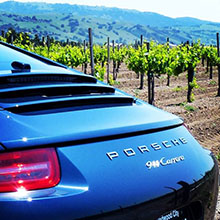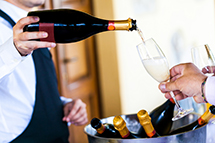|
Serving ChampagneHow to serve champagne. When a bottle of champagne has been opened through the proper procedure and observing appropriate safety measures (refer to the webpage How to Open Champagne), it is time for it to be presented to guests in the best possible light. Ensure the appropriate glassware is available for everyone (refer to the website section on Champagne Glasses). The ideal service temperature is about 40 to 45° for a non-vintage and up to 50° for more mature top cuvée. A good rule of thumb, the greater the quality of the champagne, the warmer the temperature should be to show off the complexity and distinction. If the bottle has been in an ice bucket, it may need to warm slightly before serving. If there is a large group and glasses are to be picked up at a specific location by guests, the champagne will warm in the glasses after poured. Glasses can be poured for smaller groups and guests can wait until they feel the champagne has reached the appropriate temperature. You may also let the bottle rest for a few minutes outside of the ice bucket if you believe it is much too cold. When you are ready to serve, first wipe the lip of the bottle and make sure the bottle is dry if it has been in an ice bucket. If this is a private event and you are the host, pour a small sample to taste and determine if the wine appears healthy with no off odors coming from the bottle including signs of cork taint, oxidation, maderization, etc. If you are not the host of the event, you should offer to pour the host a small sample for his or her approval. Once the champagne is deemed healthy, pour the wine for the guests or instruct waitstaff to begin pouring. Pour in a slow, steady stream. If there is foaming it is acceptable to stop while the foaming subsides and pour a second time, but in proper service, it is not acceptable to pour more than twice. If the event is such that guests are seated, each table should be approached with the females poured first in a clockwise manner from the right side and males served second in the same fashion. The host should always be served last regardless of gender. Glasses for champagne service should never be filled more than two thirds full. If you are using larger glasses than flutes, 3 or 4 ounces is appropriate depending on the number of guests and the size of the glass. You want to ensure there is room for the wine to open up and the volume is such that the taster can appreciate the aromas and flavors. For more information on tasting refer to the webpage, Champagne Characteristics. |




